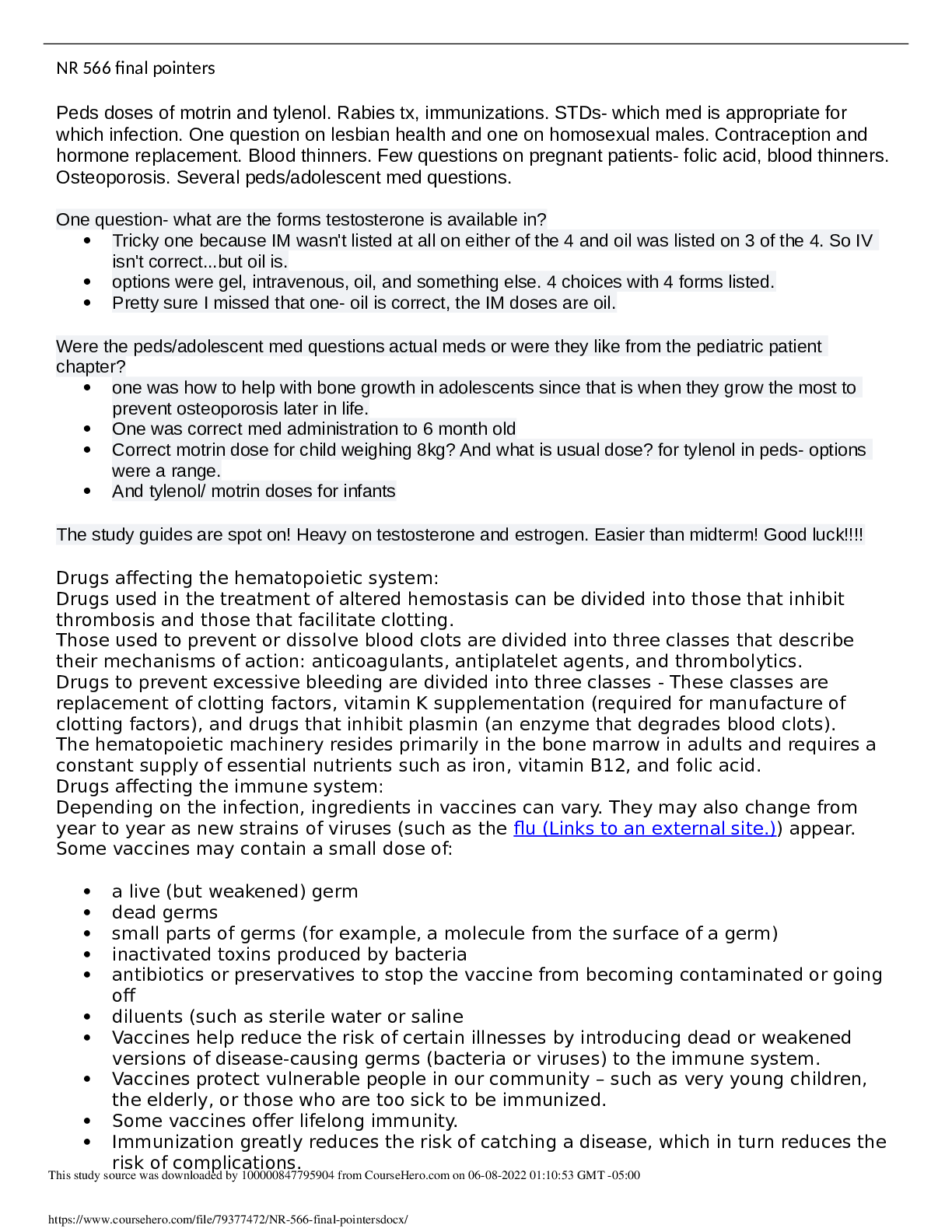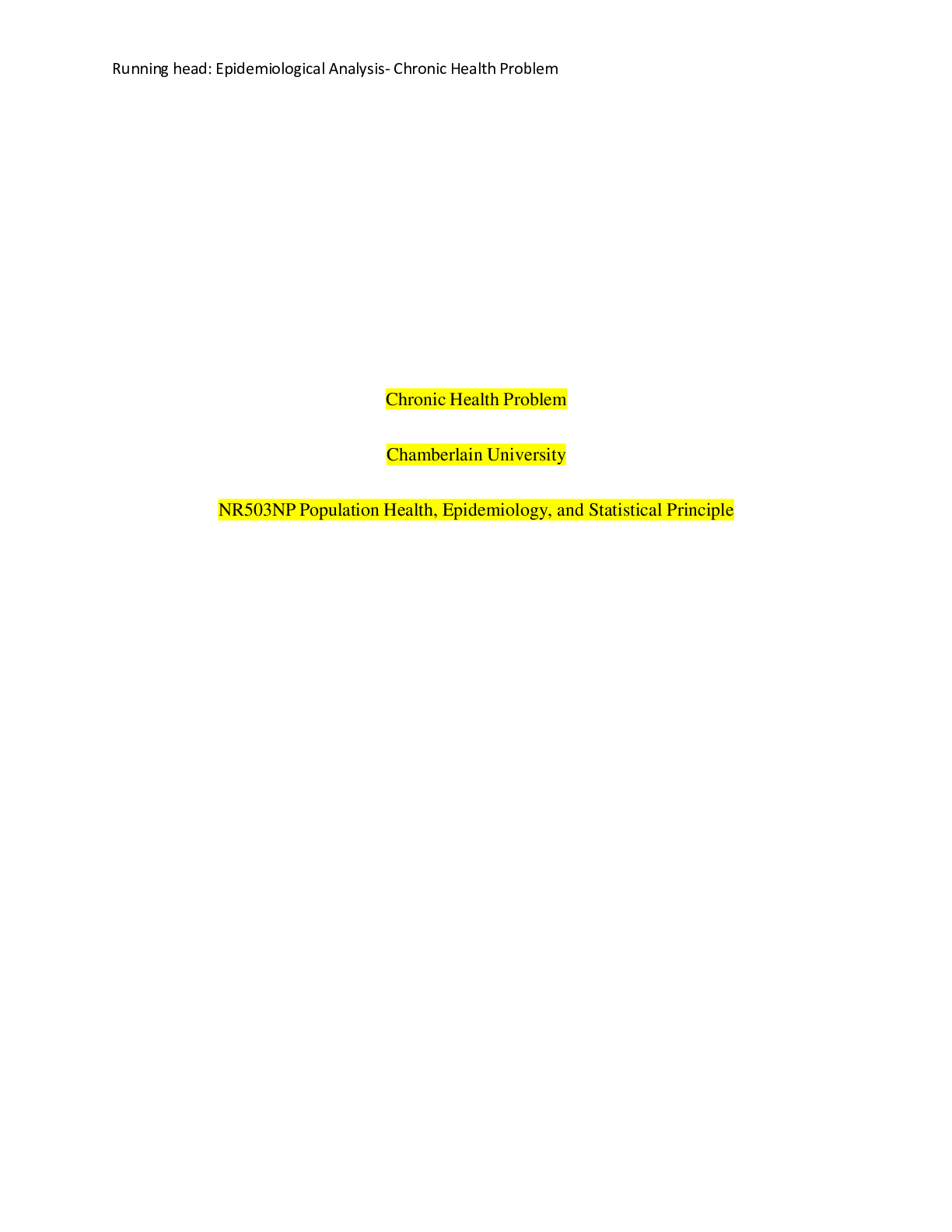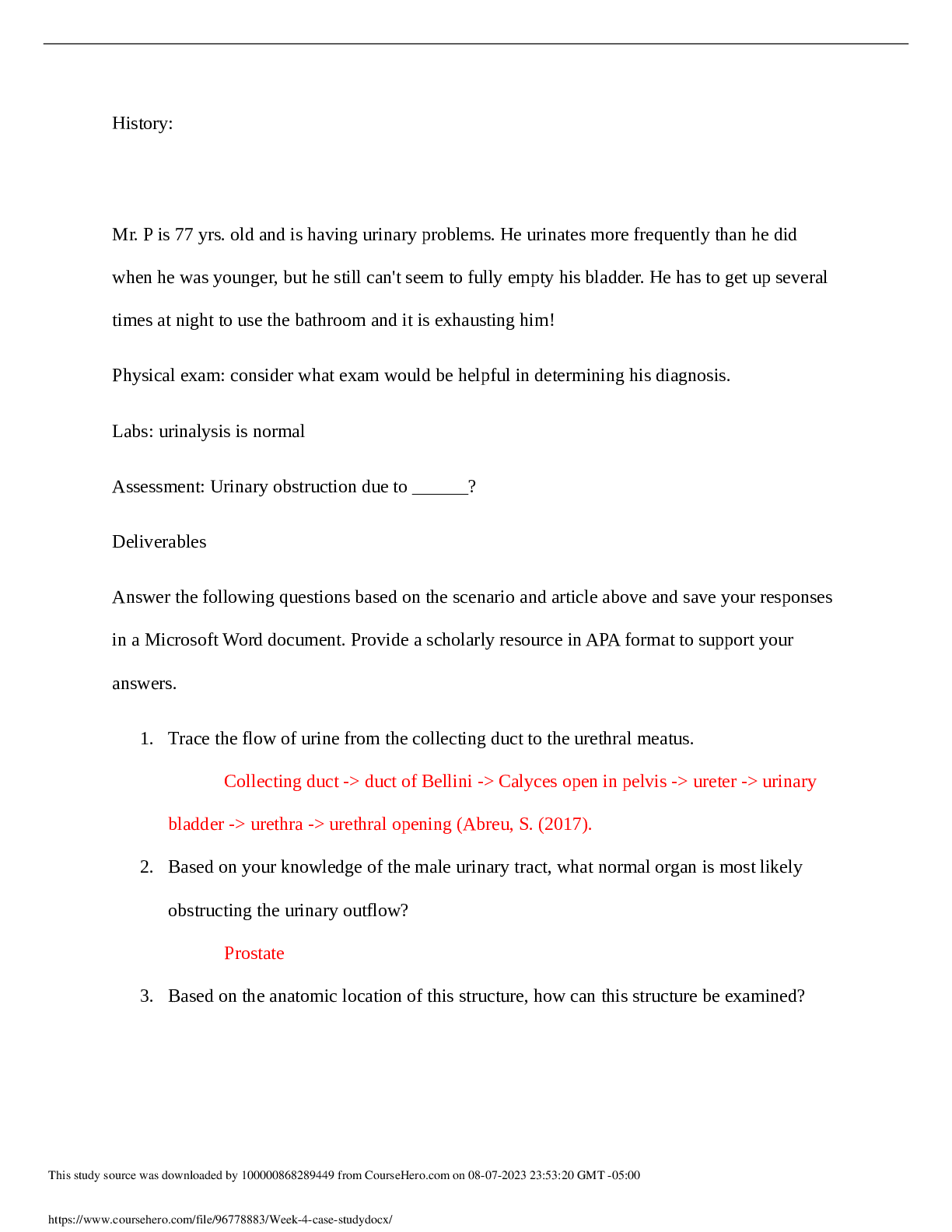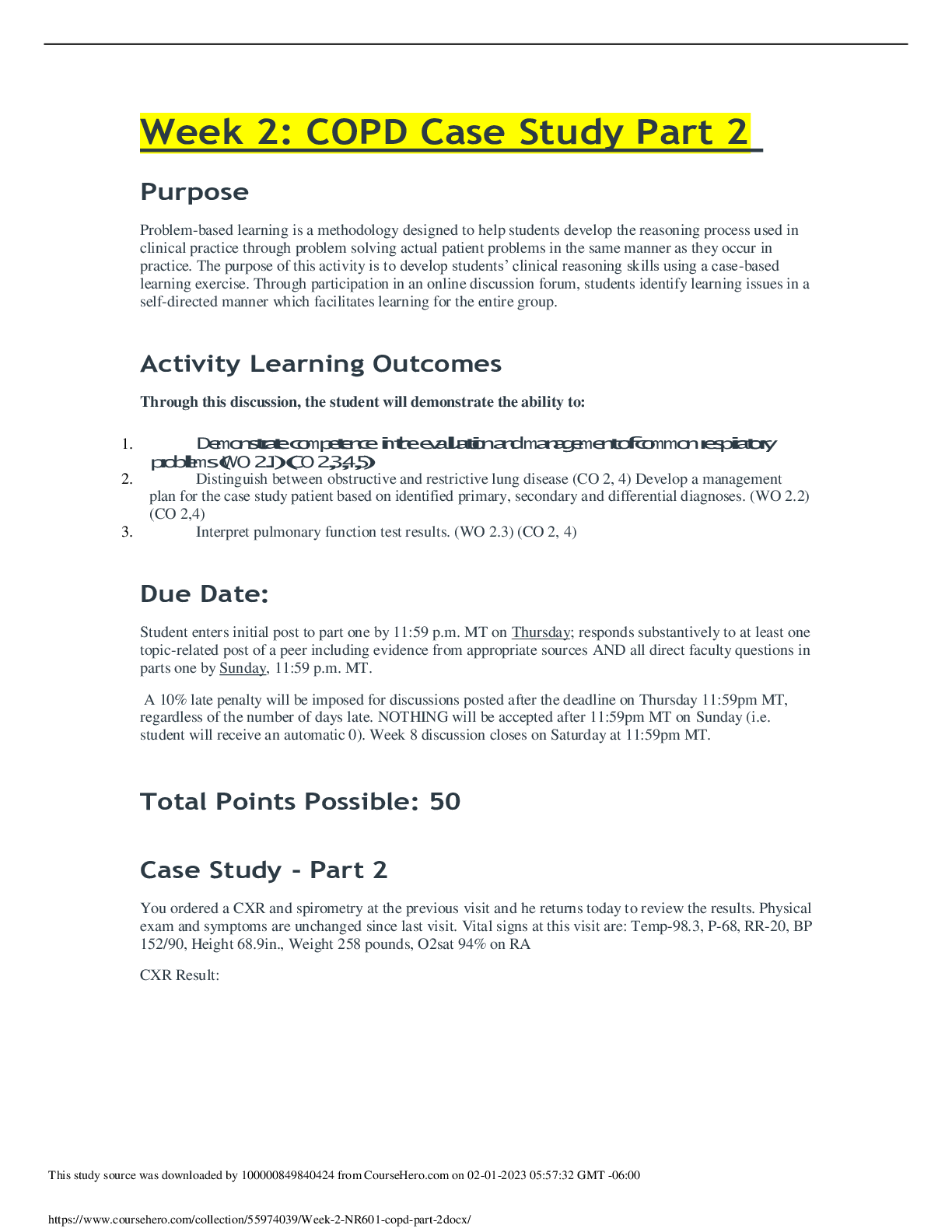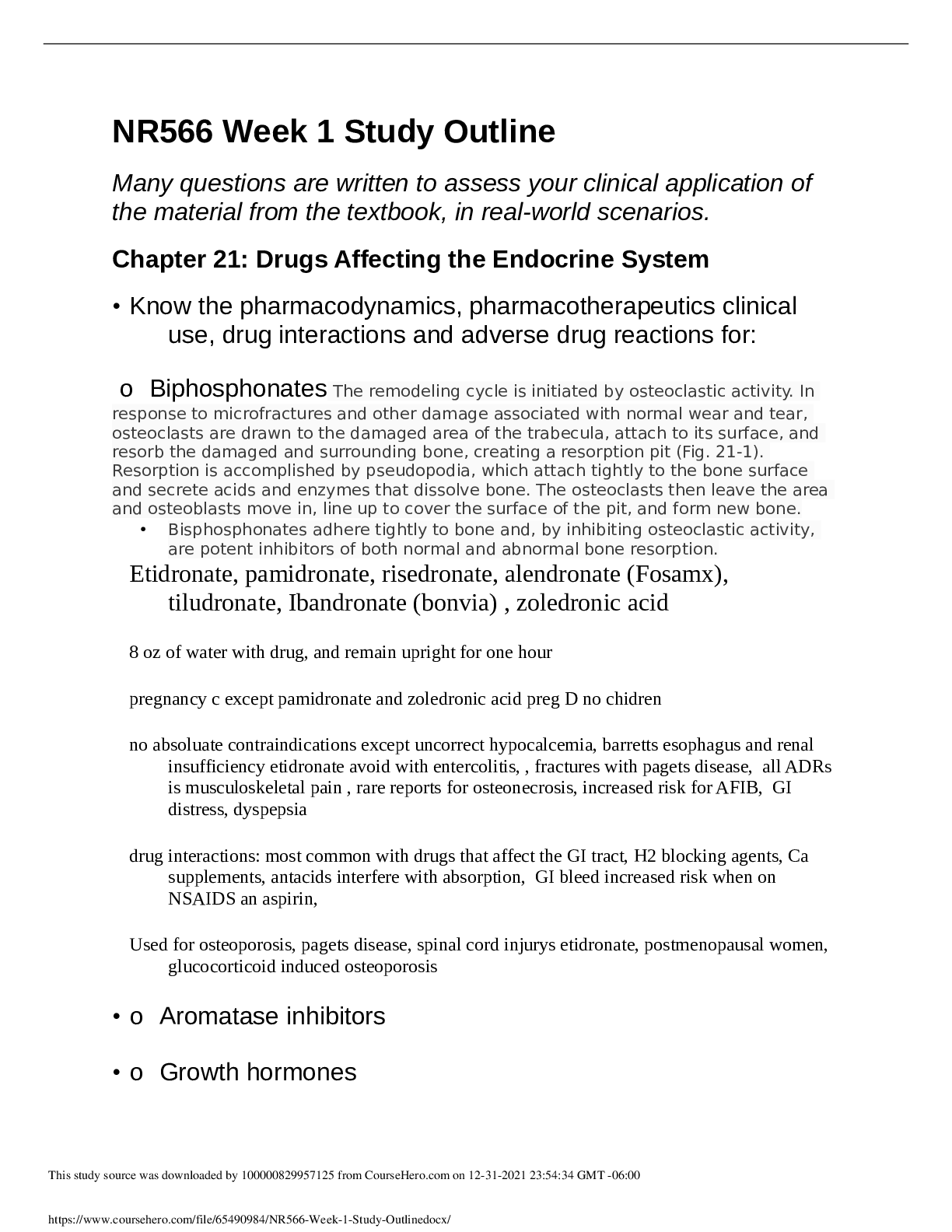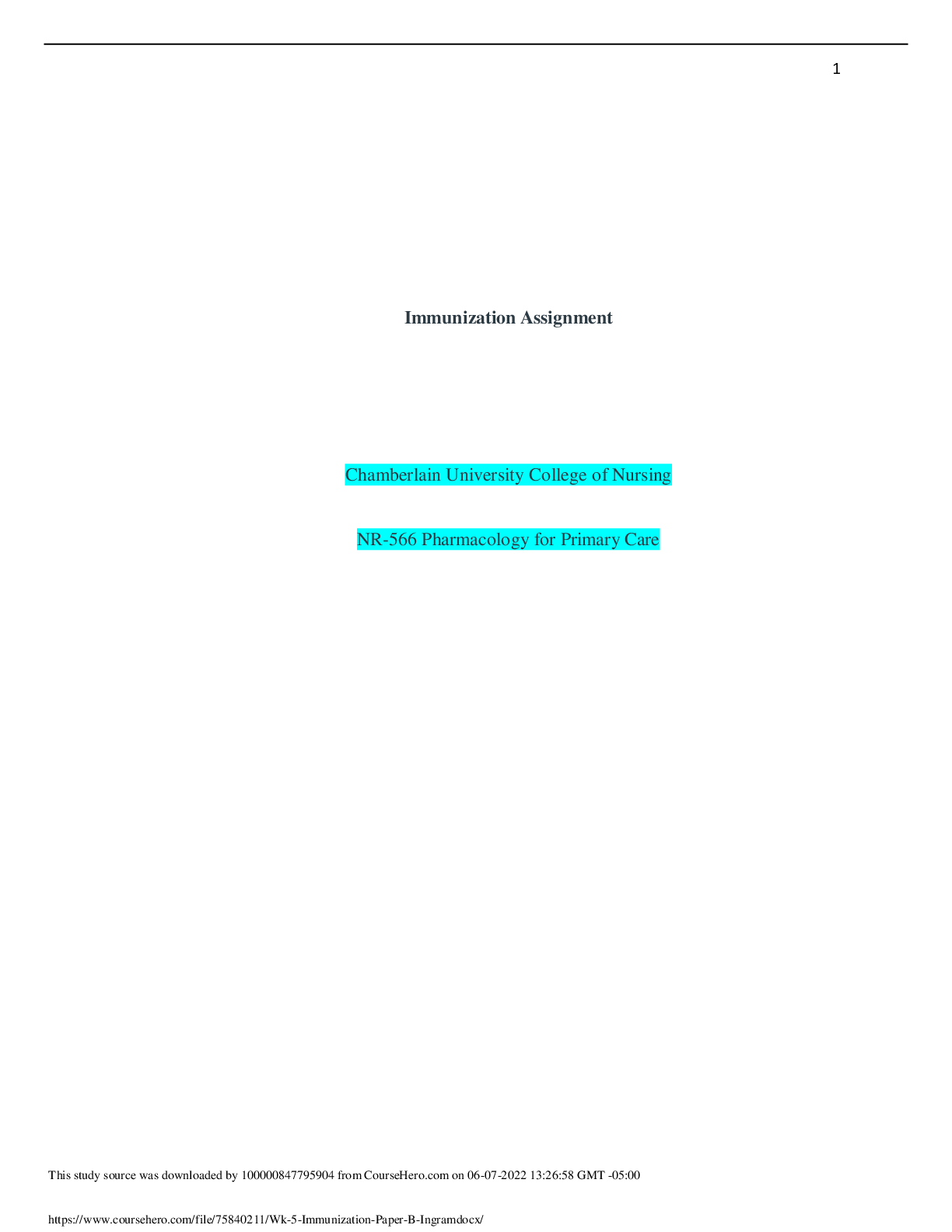*NURSING > CASE STUDY > NR-566 Week 5 Assignment: Immunization – HPV and Rotavirus (TOP SCORE) (All)
NR-566 Week 5 Assignment: Immunization – HPV and Rotavirus (TOP SCORE)
Document Content and Description Below
Running head: IMMUNIZATION Immunization Chamberlain University College of Nursing NR566-61827: Advanced Pharmacology for Care of the Family ... Immunization Immunizations take part in a crucial role in preventing illness by providing protection. Getting acquainted with the most current guidelines and recommendations on two available vaccinations to avert the occurrence of vaccine-preventable illnesses in the United States is the main intent of this paper. The human papillomavirus (HPV) vaccine and the hepatitis B vaccine with their trade names, categories of vaccination, contraindications, precautions, adverse effects, and the minimum recommended age to receive the vaccine, correct timing, and dose, and relevant special circumstances are elucidated further in detail. Finally, barriers and interventions to incorporate the reasons for reluctance to obtain the vaccine, interventions for increased compliance, and the obligation to report adverse events linked with the vaccine are discussed. Human Papillomavirus Vaccine (HPV) The trade name of HPV based on the Centers for Disease Control and Prevention (2020b) is Gardasil 9 or GARDASIL® [Human Papillomavirus Quadrivalent (Types 6, 11, 16, and 18) Vaccine, Recombinant] categorized as a subunit type of a recombinant, polysaccharide, and conjugate vaccine. Severe allergic reactions or anaphylaxis are contraindicated to the vaccine's yeast component (U.S. Department of Health & Human Services, 2020). The presence of acute illness that could be moderate or severe with or without fever is a precaution (Centers for Disease Control and Prevention, 2020a). Adverse effects and risks from the HPV vaccine are pain, redness, swelling at the injection spot, syncope, fever, or headache (Centers for Disease Control and Prevention, 2020). The minimum age requirement should be nine years old when the first dose of the HPV vaccine can be given and then nine years plus five months for the second dose to complete the recommended HPV two-dose series (Centers for Disease Control and Prevention, 2020c). To complete a two-dose series, the recommended age for HPV-1 to be given is 11 to 12 years, with a recommended interval of at least six months before the next dose can be provided. The recommended age for the second injection (HPV-2) is 11 to 12 years old. Minimum age of nine years plus five months old is needed with no more recommendations for an added dose after the second HPV vaccine has been given unless the recommended series was administered past the recommended guideline (Centers for Disease Control and Prevention, 2020c). An alternative three-dose series is an option and routinely recommended to ensure adolescents 11 or 12 years of age are safeguarded before they are exposed to the virus if the two- dose series is not followed (Centers for Disease Control and Prevention, 2019b). HPV vaccine may be provided beginning at age 9 and as late as 45 years, but those older than 26 years will not benefit from HPV vaccination. Those who get the first dose before 15 years of age need two doses of the HPV vaccine, and those who get the first dose on or after 15 years of age, and younger people with immunocompromised conditions, need the three-dose series. Each dose should be 0.5 mL given intramuscularly and given at the same time as other vaccines, except in pregnancy (Centers for Disease Control and Prevention, 2019a). Hepatitis B Vaccine (HepB) The hepatitis B vaccine's trade name is Engerix-B (Centers for Disease Control and Prevention, 2020b). HepB vaccine is also classified as a subunit type of a recombinant polysaccharide that fits into the conjugate category (U.S. Department of Health & Human Services, 2020). Severe allergic hypersensitivity reactions and anaphylaxis from a previous dose given are noted contraindications (Centers for Disease Control and Prevention, 2020b). An acute illness with or without fever is a precaution not to give the vaccine (Centers for Disease Control and Prevention, 2020b). Unfavorable drug responses are discomfort at the site of injection, lightheadedness, vision changes, tinnitus, and syncope (Centers for Disease Control and Prevention, 2020a). The Centers for Disease Control and Prevention (2020c) recommends three doses of HepB shots, with the following minimum age requirements: at birth for the first dose (HepB-1), four weeks after for the second dose (HepB-2), and at twenty-four weeks for the third dose (HepB-3) with the specified dose of 0.5 mL intramuscularly for those nineteen years old or younger and 1 mL for twenty years old and above. A special situation to note is reduced seroconversion rates in preterm infants, and the vaccine should be given when the preterm infant is one month old. Suppose the first dose of the vaccine is administered within 12 hours because the mother was positive for hepatitis B; three more doses must be administered to complete the age-appropriate series of vaccines. Regardless of low-birth-weight status, hepatitis B immunoglobulin (HBIG) is recommended in addition to HepB vaccines. All foreign-born individuals must remain tested, regardless of vaccination status for HBsAg, and should be vaccinated if they are not yet immune (Centers for Disease Control and Prevention, 2019a). The HepB vaccine has special considerations and required age- appropriate doses to complete the series of immunizations. Barriers, Interventions, and Reporting A specified barrier to vaccine non-compliance is the lack of access prevalent in low- income areas owing to unavailable healthcare services (Sheerin et al., 2017). Nurse practitioners can improve vaccination compliance through effective policymaking, collaborative networking, and partnerships to help generate services and available vaccination sites in rural areas (Sheerin et al., 2017). Vaccine reluctance and hesitancy depend directly on the compulsory nature of vaccines, adverse health consequences, unawareness of vaccine-preventable diseases, the dearth of trust in public health agencies, and parental acceptance of vaccines, which requires confidence in the healthcare providers who recommend and administer vaccines, and the systems to make sure vaccines are safe (Salmon et al., 2015). Healthcare providers are compelled to report by law any undesirable occurrence to the Vaccine Adverse Event Reporting System (VAERS) to monitor problems following vaccination (Centers for Disease Control and Prevention, 2020d). The VAERS table denotes adverse outcomes that should be noted, such as anaphylactic shock reactions and vasovagal syncope within a seven-day period, brachial neuritis in 28 days, shoulder injury, acute complications, or sequelae. Health care providers are similarly obliged to report the noted adverse events after the vaccine was administered based on the manufacturer's listed contraindications, even if there was uncertainty about what caused the event (Centers for Disease Control and Prevention, 2020d). Also, providers are urged to report any errors in vaccine administration by submitting a VAERS report online or downloading a written form completed electronically through the VAERS website. In this way, compliance with reporting adverse events related to vaccine administration is reported and tracked as mandatory by law (Centers for Disease Control and Prevention, 2020d). Both the HPV and the HepB vaccine are mutually beneficial vaccination approaches that help out thwart certain vaccine-preventable illnesses recognized to be detrimental to the community at large. Further research is necessary to pinpoint the best resource dissemination mechanisms and address barriers to overcome non-compliance with recommended vaccinations (Scherr et al., 2016). Partnership with organizations is a good resource for nurse practitioners to report adverse events related to immunizations to foster well-being and safe administration of vaccines within the community. Vaccinations have progressed effectively in the long run and play an important part in the preventative treatment of primarily protecting the community. References Centers for Disease Control and Prevention. (2019a). Special situations. U.S. Department of Health & Human Services. https://www.cdc.gov/vaccines/hcp/acip-recs/general- recs/special-situations.html Centers for Disease Control and Prevention. (2019b). HPV Vaccine Information Statements. U.S. Department of Health & Human Services. https://www.cdc.gov/vaccines/hcp/vis/vis- statements/hpv.html Centers for Disease Control and Prevention. (2020a). Possible side effects from vaccines. U.S. Department of Health & Human Services. https://www.cdc.gov/vaccines/vac-gen/side- effects.htm Centers for Disease Control and Prevention. (2020b). Contraindications and precautions. U.S. Department of Health & Human Services. https://www.cdc.gov/vaccines/hcp/acip- recs/general-recs/contraindications.html Centers for Disease Control and Prevention. (2020c). Timing and spacing of immunobiologics. U.S. Department of Health & Human Services. https://www.cdc.gov/vaccines/hcp/acip- recs/general-recs/timing.html Centers for Disease Control and Prevention. (2020d). Reporting adverse events. U.S. Department of Health & Human Services. https://www.cdc.gov/vaccinesafety/hcproviders/reportingadverseevents.html Scherr, C. L., Augusto, B., Ali, K., Malo, T. L., & Vadaparampil, S. T. (2016). Provider-reported acceptance and use of the Centers for Disease Control and Prevention messages and materials to support HPV vaccine recommendation for adolescent males. Vaccine, 34(35), 4229–4234. https://doi.org/10.1016/j.vaccine.2016.06.037 Sheerin, D., Openshaw, P. J., & Pollard, A. J. (2017). Issues in vaccinology: Present challenges and future directions. European Journal of Immunology, 47(12), 2017–2025. https://doi- org.chamberlainuniversity.idm.oclc.org/10.1002/eji.201746942 Salmon, D. A., Dudley, M. Z., Glanz, J. M., & Omer, S. B. (2015). Vaccine hesitancy: Causes, consequences, and a call to action. Vaccine, 33, D66–D71. https://doi.org/10.1016/j.vaccine.2015.09.035 U.S. Department of Health & Human Services. (2020). Vaccine types. Office of Infectious Disease and HIV/AIDS Policy. https://www.vaccines.gov/basics/types [Show More]
Last updated: 2 years ago
Preview 1 out of 8 pages
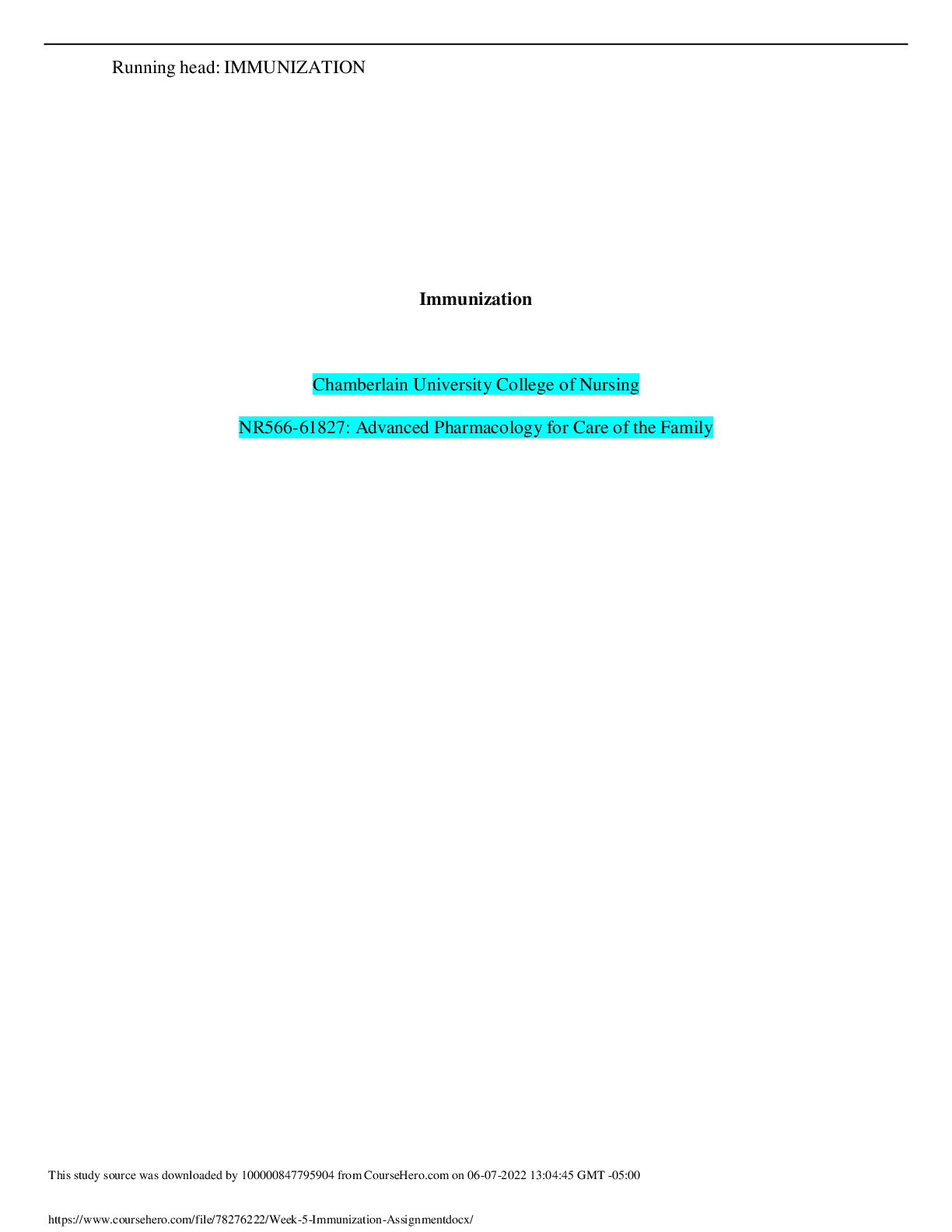
Buy this document to get the full access instantly
Instant Download Access after purchase
Buy NowInstant download
We Accept:

Reviews( 0 )
$13.50
Can't find what you want? Try our AI powered Search
Document information
Connected school, study & course
About the document
Uploaded On
Jun 07, 2022
Number of pages
8
Written in
Additional information
This document has been written for:
Uploaded
Jun 07, 2022
Downloads
0
Views
120
